Empirical Subseasonal Prediction of Summer Rainfall Anomalies over the Middle and Lower Reaches of the Yangtze River Basin Based on Atmospheric Intraseasonal Oscillation
Abstract
:1. Introduction
2. Data, Method and Model
3. Predictability Sources and Projection Domains
4. Results
4.1. Prediction Skill
4.2. Factors Affecting the Year-to-Year Variation of Prediction Skill
5. Conclusions and Discussion
Acknowledgments
Author Contributions
Conflicts of Interest
References
- Zhu, Q.; He, J.; Wang, P. A study of circulation differences between East Asian and Indian summer monsoons with their interaction. Adv. Atmos. Sci. 1986, 3, 466–477. [Google Scholar]
- Zhu, Z.; He, J.; Qi, L. Seasonal transition of East Asian subtropical monsoon and its possible mechanism. J. Trop. Meteorol. 2012, 18, 305–313. [Google Scholar]
- Chang, C.-P. East Asian Monsoon; World Scientific Publishing Co.: Hackensack, NJ, USA, 2004; pp. 5–6. [Google Scholar]
- Wang, B.; Lee, J.; Xiang, B. Asian summer monsoon rainfall predictability: A predictable mode analysis. Clim. Dynam. 2015, 44, 61–74. [Google Scholar]
- Wang, B.; Wu, R.; Fu, X. Pacific-East Asia teleconnection: How does ENSO affect East Asian climate? J. Clim. 2000, 13, 1517–1536. [Google Scholar]
- Wu, B.; Li, T.; Zhou, T. Relative contributions of the Indian Ocean and local SST anomalies to the maintenance of the western North Pacific anomalous anticyclone during the El Niño decaying summer. J. Clim. 2010, 23, 2974–2986. [Google Scholar]
- Lorenz, E. Atmospheric predictability as revealed by naturally occurring analogues. J. Atmos. Sci. 1969, 26, 636–646. [Google Scholar]
- Van, D.; Saha, S. Frequency dependence in forecast skill. Mon. Weather Rev. 1990, 118, 128–137. [Google Scholar]
- Kim, D.; Sperber, K.; Stern, W.; Waliser, D.; Kang, I.-S.; Maloney, E.; Wang, W.; Weickmann, K.; Benedict, J.; Khairoutdinov, M.; et al. Application of MJO simulation diagnostics to climate models. J. Clim. 2009, 22, 6413–6436. [Google Scholar] [CrossRef]
- Zhang, C.; Gottschalck, J.; Maloney, E.; Moncrieff, M.; Vitart, F.; Waliser, D.; Wang, B.; Wheeler, M. Cracking the MJO nut. Geo. Res. Lett. 2013, 40, 1223–1230. [Google Scholar] [CrossRef]
- Hung, M.; Lin, J.; Wang, W.; Kim, D.; Shinoda, T.; Weaver, S. MJO and convectively coupled equatorial waves simulated by CMIP5 climate models. J. Clim. 2013, 26, 6185–6214. [Google Scholar]
- Jiang, X.; Waliser, D.; Wheeler, M.; Jones, C.; Lee, M.; Schubert, S. Assessing the skill of an all-season statistical forecast model for the Madden-Julian oscillation. Mon. Weather Rev. 2008, 136, 1940–1956. [Google Scholar] [CrossRef]
- Kang, I.; Kim, H. Assessment of MJO predictability for boreal winter with various statistical and dynamical models. J. Clim. 2010, 23, 2368–2378. [Google Scholar] [CrossRef]
- Roundy, P. Tracking and prediction of large-scale organized tropical convection by spectrally focused two-step space-time EOF analysis. Q. J. R. Meteorol. Soc. 2012, 138, 919–931. [Google Scholar] [CrossRef]
- Cavanaugh, N.; Teddy, A.; Subramanian, A.; Mapes, B.; Seo, H.; Miller, A. The skill of atmospheric linear inverse models in hindcasting the Madden-Julian oscillation. Clim. Dynam. 2014, 44, 897–906. [Google Scholar] [CrossRef]
- Lee, S.; Wang, B. Regional boreal summer intraseasonal oscillation over Indian Ocean and Western Pacific: comparison and predictability study. Clim. Dynam. 2016, 46, 2213–2229. [Google Scholar] [CrossRef]
- Zhu, Z.; Li, T.; Hsu, P.; He, J. A spatial-temporal projection model for extended-range forecast in the tropics. Clim. Dynam. 2015, 45, 1085–1098. [Google Scholar] [CrossRef]
- Zhu, Z.; Li, T. The statistical extended range (10–30 day) forecast of summer rainfall anomalies over the entire China. Clim. Dynam. 2017, 48, 209–224. [Google Scholar] [CrossRef]
- Zhu, Z.; Li, T. Statistical extended-range forecast for the winter surface air temperature and extreme cold days over China. Q. J. R. Meteorol. Soc. 2017, 143, 1528–1538. [Google Scholar] [CrossRef]
- Zhu, Z.; Li, T. Extended-range forecasting of Chinese summer surface air temperature and heat waves. Clim. Dynam. 2017, in press. [Google Scholar] [CrossRef]
- Zhu, Z.; Li, T. Empirical prediction of the onset dates of South China Sea summer monsoon. Clim. Dynam. 2017, 48, 1633–1645. [Google Scholar] [CrossRef]
- Zhu, Z.; Li, T.; Bai, L.; Gao, J. Extended-range forecast for the temporal distribution of clustering tropical cyclogenesis over the western North Pacific. Theor. Appl. Climatol. 2017, in press. [Google Scholar] [CrossRef]
- Kanamitsu, M.; Ebisuzaki, W.; Woollen, J.; Yang, S.; Hnilo, J.; Fiorino, M.; Potter, G. NCEP-DOE AMIP-II reanalysis (R-2). Bull. Am. Meteorol. Soc. 2002, 83, 1631–1643. [Google Scholar] [CrossRef]
- Liebmann, B.; Smith, C. Description of a complete (interpolated) outgoing longwave radiation dataset. Bull. Am. Meteorol. Soc. 1996, 77, 1275–1277. [Google Scholar]
- Horel, J. A rotated principal component analysis of the interannual variability of the Northern Hemisphere 500 mb height field. Mon. Weather Rev. 1981, 109, 2080–2092. [Google Scholar] [CrossRef]
- Yuan, K.; Zhu, Z.; Li, M. A pair of new moisture-dynamic diagnostic parameters for heavy rain location. Meteorol. Atmos. Phys. 2017, in press. [Google Scholar] [CrossRef]
- Saha, S.; Moorthi, S.; Wu, S.; Wang, X.J.; Nadiga, S.; Tripp, P.; Behringer, D.; Hou, Y.T.; Chuang, H.Y.; Iredell, M.; et al. The NCEP climate forecast system version 2. J. Clim. 2014, 27, 2185–2208. [Google Scholar] [CrossRef]
- Lee, S.; Wang, B.; Waliser, D.; Neena, J.; Lee, J. Predictability and prediction skill of the boreal summer intraseasonal oscillation in the intraseasonal variability hindcast experiment. Clim. Dynam. 2015, 45, 2123–2135. [Google Scholar] [CrossRef]
- Yang, J.; Wang, B.; Wang, B.; Bao, Q. Biweekly and 21–30-day variations of the subtropical summer monsoon rainfall over the lower reach of the Yangtze River basin. J. Clim. 2010, 23, 1146–1159. [Google Scholar] [CrossRef]
- Livezey, R.E.; Chen, W.Y. Statistical Field Significance and its Determination by Monte Carlo Techniques. Mon. Weather Rev. 1983, 111, 46–59. [Google Scholar] [CrossRef]
- Cressman, J. An operational objective analysis system. Mon. Weather Rev. 1959, 87, 367–374. [Google Scholar] [CrossRef]
- Liu, F.; Li, T.; Wang, H.; Deng, L.; Zhang, Y. Modulation of boreal summer intraseasonal oscillation over the western North Pacific by the ENSO. J. Clim. 2016, 29, 7189–7201. [Google Scholar] [CrossRef]
- Matsuno, T. Quasi-geostrophic motions in the equatorial area. J. Meteorol. Soc. Jpn. 1966, 44, 25–43. [Google Scholar] [CrossRef]
- Gill, A. Some simple solutions for heat-induced tropical circulations. Q. J. R. Meteorol. Soc. 1980, 106, 447–462. [Google Scholar] [CrossRef]
- Zhu, Z.; Li, T.; He, J. Out-of-phase relationship between boreal spring and summer decadal rainfall changes in southern China. J. Clim. 2014, 27, 1083–1099. [Google Scholar] [CrossRef]
- Zhu, Z.; Li, T. The record-breaking hot summer in 2015 over Hawaiian Islands and its physical causes. J. Clim. 2017, 30, 4253–4266. [Google Scholar] [CrossRef]
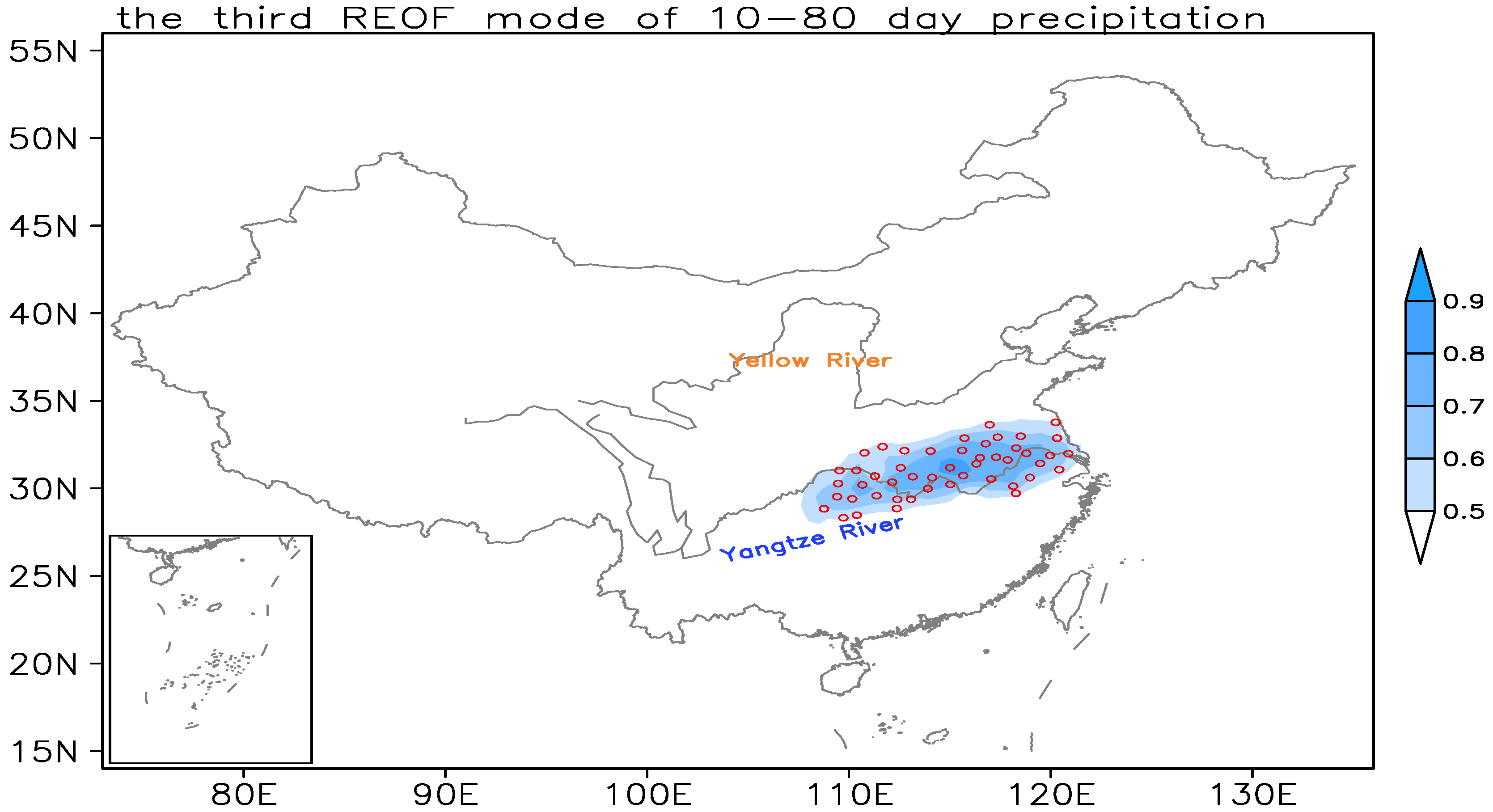
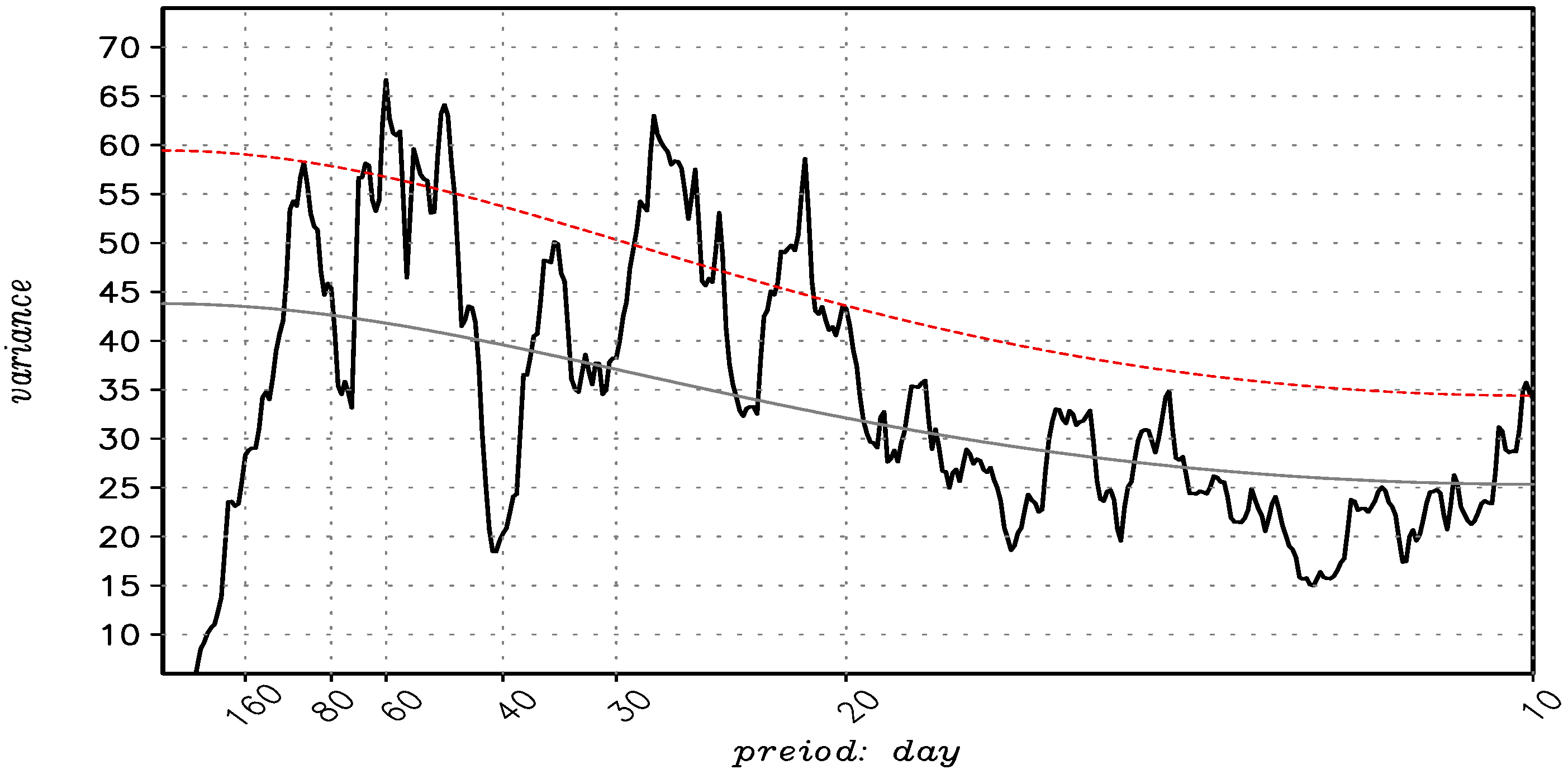
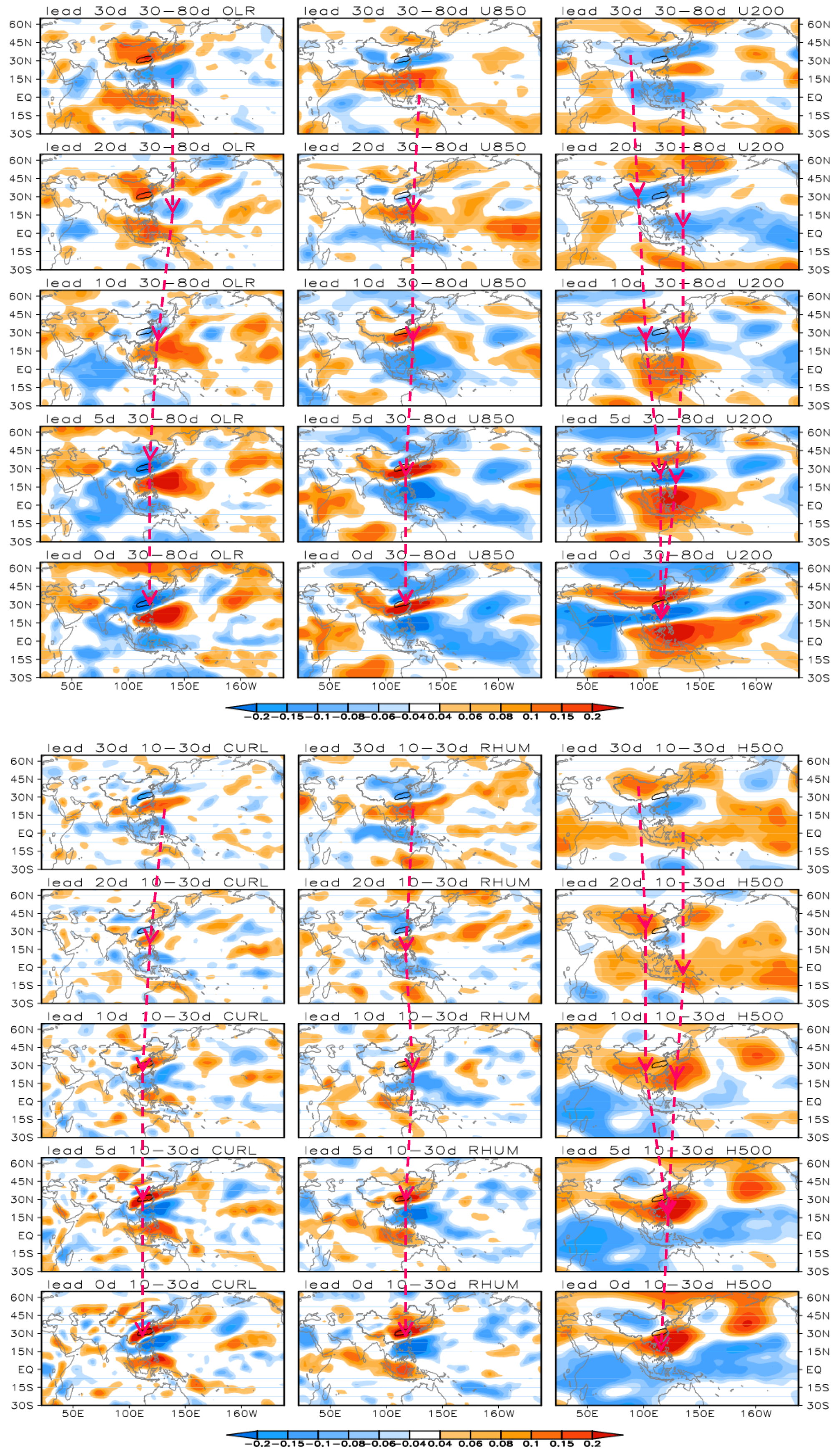
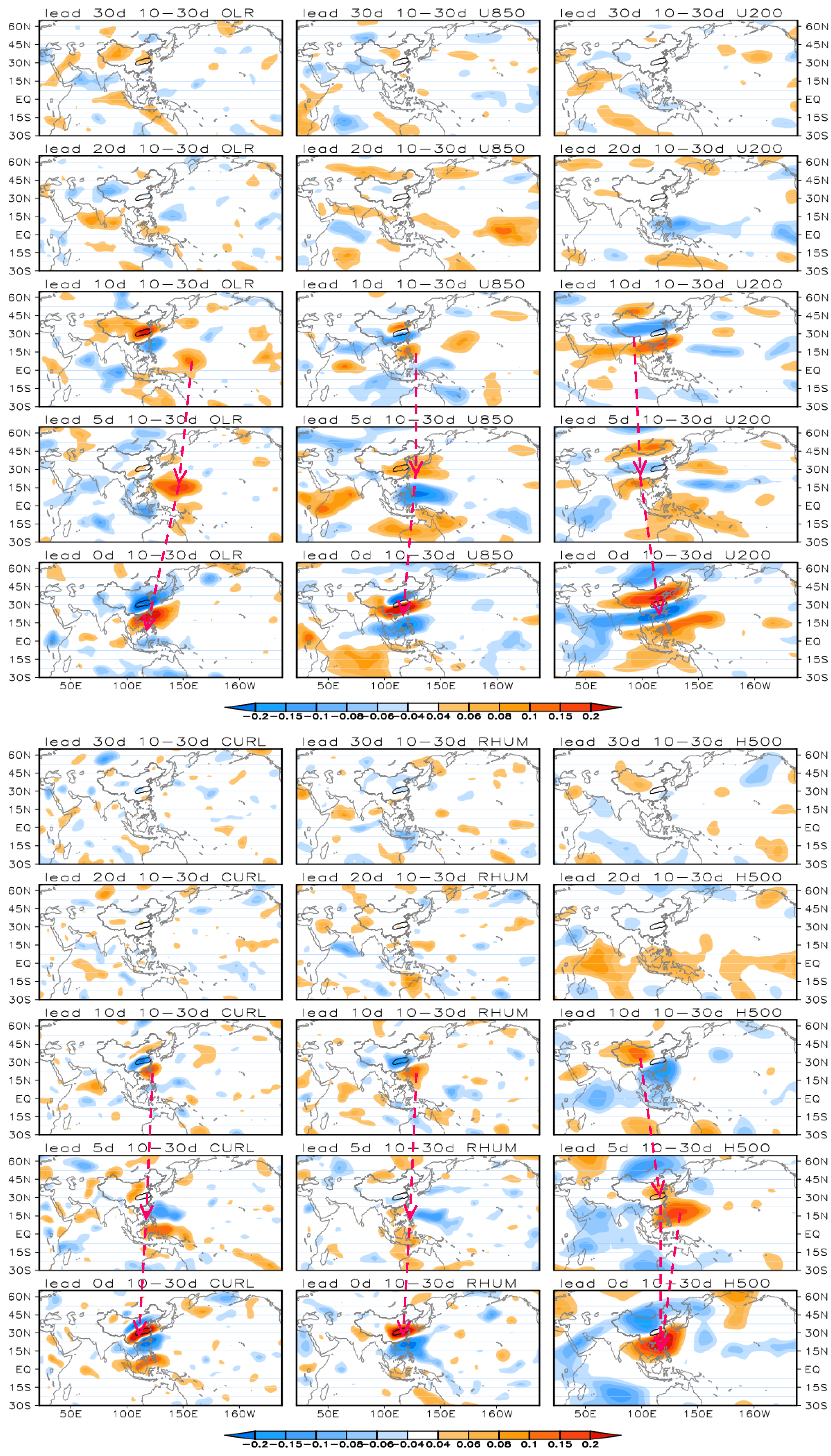


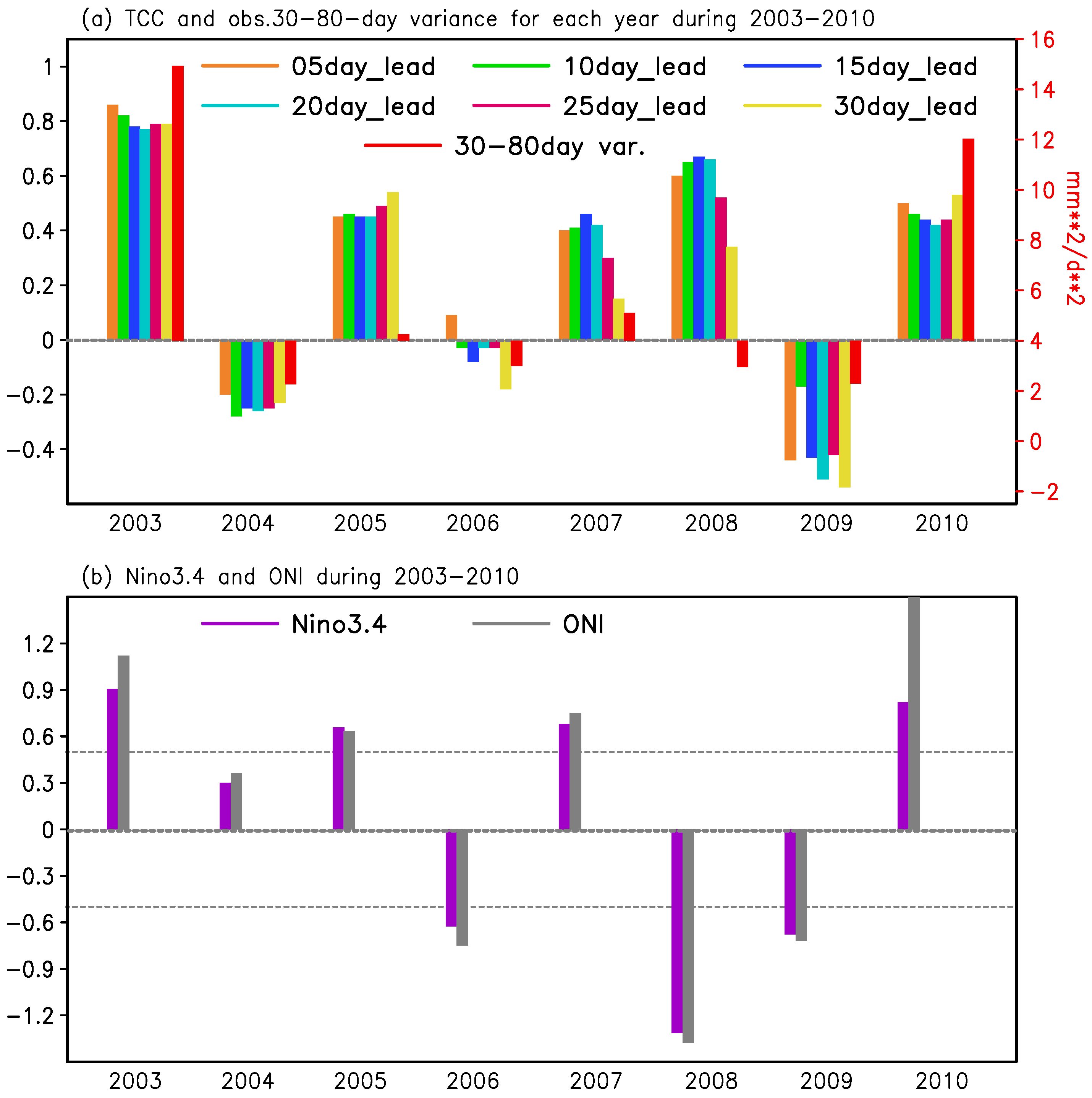

| Name | Coordinate | Name | Coordinate | Name | Coordinate | Name | Coordinate |
|---|---|---|---|---|---|---|---|
| Fangxian | 32.03; 110.77 | Tianmen | 30.67; 113.17 | Suzhou | 33.63; 116.98 | Huoshan | 31.40; 116.32 |
| Laohekou | 32.38; 111.67 | Wuhan | 30.62; 114.13 | Xuyi | 32.98; 118.52 | Hefei | 31.78; 117.30 |
| Zaoyang | 32.15; 112.75 | Laifeng | 29.52; 109.42 | Sheyang | 33.77; 120.2 | Chaohu | 31.62; 117.87 |
| Xinyang | 32.13; 114.05 | Sangzhi | 29.40; 110.17 | Fuyang | 32.87; 115.73 | Changzhou | 31.88; 119.98 |
| Fengjie | 31.02; 109.53 | Shimen | 29.58; 111.37 | Gushi | 32.17; 115.62 | Liyang | 31.43; 119.48 |
| Badong | 31.03; 110.37 | Nanxian | 29.37; 112.40 | Shouxian | 32.55; 116.78 | Dongshan | 31.07; 120.43 |
| Zhongxiang | 31.17; 112.57 | Jiayu | 29.98; 113.92 | Bengbu | 32.92; 117.38 | Yingshan | 30.73; 115.67 |
| Macheng | 31.18; 115.02 | Yueyang | 29.38; 113.08 | Chuzhou | 32.30; 118.30 | Huangshi | 30.23; 115.03 |
| Enshi | 30.28; 109.47 | Youyang | 28.83; 108.77 | Nanjing | 32.00; 118.80 | Anqing | 30.53; 117.05 |
| Wufeng | 30.20; 110.67 | Jishou | 28.32; 109.73 | Dongtai | 32.87; 120.32 | Ningguo | 30.62; 118.98 |
| Yichang | 30.70; 111.40 | Yuanling | 28.47; 110.40 | Nantong | 31.98; 120.88 | Huangshan | 30.13; 118.15 |
| Jingzhou | 30.35; 112.15 | Yuanjiang | 28.85; 112.37 | Liuan | 31.75; 116.50 | Tunxi | 29.72; 118.28 |
© 2017 by the authors. Licensee MDPI, Basel, Switzerland. This article is an open access article distributed under the terms and conditions of the Creative Commons Attribution (CC BY) license (http://creativecommons.org/licenses/by/4.0/).
Share and Cite
Zhu, Z.; Chen, S.; Yuan, K.; Chen, Y.; Gao, S.; Hua, Z. Empirical Subseasonal Prediction of Summer Rainfall Anomalies over the Middle and Lower Reaches of the Yangtze River Basin Based on Atmospheric Intraseasonal Oscillation. Atmosphere 2017, 8, 185. https://doi.org/10.3390/atmos8100185
Zhu Z, Chen S, Yuan K, Chen Y, Gao S, Hua Z. Empirical Subseasonal Prediction of Summer Rainfall Anomalies over the Middle and Lower Reaches of the Yangtze River Basin Based on Atmospheric Intraseasonal Oscillation. Atmosphere. 2017; 8(10):185. https://doi.org/10.3390/atmos8100185
Chicago/Turabian StyleZhu, Zhiwei, Shengjie Chen, Kai Yuan, Yini Chen, Song Gao, and Zhenfei Hua. 2017. "Empirical Subseasonal Prediction of Summer Rainfall Anomalies over the Middle and Lower Reaches of the Yangtze River Basin Based on Atmospheric Intraseasonal Oscillation" Atmosphere 8, no. 10: 185. https://doi.org/10.3390/atmos8100185





